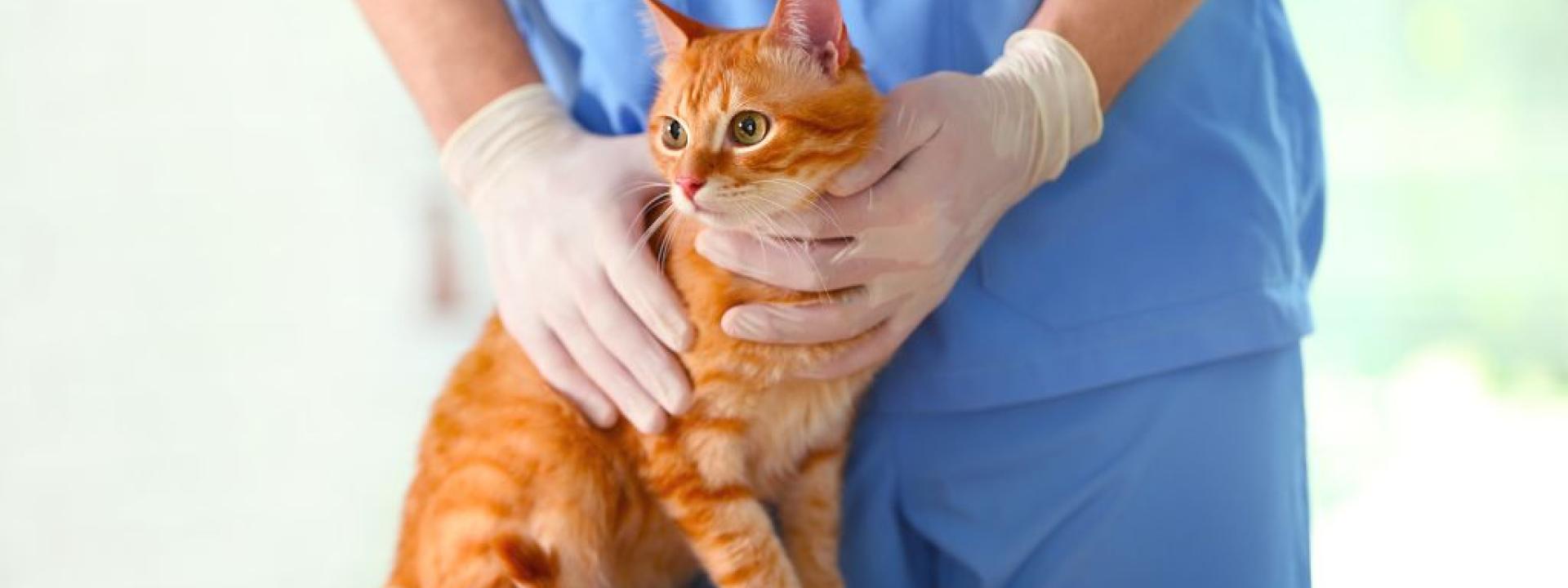As a veterinarian, I often encounter feline patients struggling with thyroid issues that can significantly impact their cat’s health and quality of life. Two primary thyroid disorders affect cats: hyperthyroidism and hypothyroidism. Understanding these conditions, their symptoms, and treatment options can help cat owners provide the best care for their four-legged partners.
In this blog, we’ll explore the details of hyperthyroidism and hypothyroidism, exploring their symptoms, diagnosis, and treatment options. I will break them down into smaller chunks to make them easier to digest and hopefully help demystify these diseases. By understanding these thyroid disorders, you can help your feline friend receive the best possible care and maintain a good quality of life.
Hyperthyroidism and Hypothyroidism in Cats
Hyperthyroidism is the more common thyroid disorder in cats, mainly affecting our whiskered companions over ten years old. Studies indicate that up to 10% of senior cats may develop hyperthyroidism, making it a prevalent concern for aging felines. This condition results from an overproduction of thyroid hormone, leading to a range of symptoms that can affect your cat's weight, appetite, and overall behavior.
On the other hand, hypothyroidism is much less common in cats but can still occur. This condition is typically seen in younger cats if congenital or in older cats as a secondary effect of treatment for hyperthyroidism. Hypothyroidism occurs when there is an underproduction of thyroid hormone, which can slow down your cat’s metabolism and cause various health issues.
Why Cats Develop Thyroid Disorders
Understanding why cats develop thyroid disorders such as hypothyroidism and hyperthyroidism can help pet owners better manage and prevent these conditions. Remember, our veterinary team will also be with you every step of the way and available for any questions you may have!
Here’s a detailed look at the causes of both hypothyroidism and hyperthyroidism in cats.

Causes of Hyperthyroidism
Benign Thyroid Adenomas: The most common cause of hyperthyroidism in cats is benign (non-cancerous) growths called adenomas in the thyroid gland. These adenomas lead to an overproduction of thyroid hormones.
Thyroid Carcinomas: Although rare, malignant (cancerous) tumors in the thyroid gland, known as thyroid carcinomas, can also cause hyperthyroidism. These cases are less common but require more aggressive treatment.
Environmental Factors: Some studies suggest that exposure to certain environmental factors, such as chemicals in food or the home environment, might contribute to the development of hyperthyroidism. However, the exact role of these factors is not yet fully understood.
Dietary Factors: Diets high in iodine have been implicated in the development of hyperthyroidism in cats. Iodine is essential for thyroid hormone production, and an imbalance can disrupt normal thyroid function.
Causes of Hypothyroidism
Congenital Hypothyroidism: Some cats are born with hypothyroidism due to genetic defects that affect thyroid hormone production. This is typically diagnosed in younger cats.
Secondary Hypothyroidism: This form of hypothyroidism occurs as a secondary effect of other conditions or treatments. The most common scenario in cats is secondary hypothyroidism following the treatment of hyperthyroidism. Treatments such as radioactive iodine therapy or surgical removal of the thyroid gland can sometimes lead to a deficiency in thyroid hormone production.
Iatrogenic Hypothyroidism: This type of hypothyroidism is caused by medical intervention, often as a result of overtreatment for hyperthyroidism. For example, administering too high a dose of anti-thyroid medications or radioactive iodine can suppress thyroid function too much, leading to hypothyroidism.
Inflammatory Thyroiditis: In rare cases, autoimmune conditions can cause thyroid gland inflammation (thyroiditis), leading to reduced thyroid hormone production.

Symptoms of Hyperthyroidism in Cats
Cats with hyperthyroidism often exhibit several symptoms, including:
- Weight Loss: Despite an increased appetite, cats with hyperthyroidism often experience significant weight loss. This is due to the accelerated metabolism caused by excess thyroid hormone, which increases the body’s energy expenditure.
- Increased Appetite (Polyphagia): One of the hallmark signs of hyperthyroidism is an increased appetite. Cats with this condition may seem ravenous and beg for food more frequently, yet continue to lose weight.
- Increased Thirst and Urination (Polydipsia and Polyuria): Hyperthyroid cats often drink more water and urinate more frequently. This can lead to dehydration if not properly managed, as the body tries to compensate for the increased metabolic activity.
- Hyperactivity and Restlessness: Cats with hyperthyroidism may become unusually hyperactive or restless. They might display nervous or aggressive behaviors and have difficulty settling down or sleeping.
- Vomiting and Diarrhea: Gastrointestinal symptoms such as vomiting and diarrhea are common in hyperthyroid cats. These symptoms can exacerbate weight loss and dehydration.
- Poor Coat Condition: The coat of a hyperthyroid cat may appear unkempt, greasy, or matted. They might also exhibit excessive grooming behaviors, leading to bald patches or skin irritation.
- Rapid Heart Rate (Tachycardia): A high heart rate is a frequent finding in hyperthyroid cats. This increased cardiac workload can lead to secondary heart issues, such as hypertrophic cardiomyopathy (enlarged heart).
- Respiratory Problems: Some cats with hyperthyroidism may develop respiratory issues, including rapid breathing or shortness of breath, due to the increased metabolic demand on their body.
- Increased Vocalization: Owners often notice that their hyperthyroid cats become more vocal. Increased meowing or yowling, especially at night, can be a sign of discomfort or anxiety related to the condition.
- Weakness and Muscle Wasting: Muscle weakness and wasting are common in advanced stages of hyperthyroidism. This occurs because the body breaks down muscle tissue to provide energy for the heightened metabolism.
Symptoms of Hypothyroidism in Cats
Cats with hypothyroidism may show the following symptoms:
- Weight Gain: Despite a normal or decreased appetite, cats with hypothyroidism often gain weight. This is due to the slowed metabolism caused by a deficiency in thyroid hormone.
- Lethargy and Decreased Activity: Cats with hypothyroidism typically exhibit lethargy and a decreased interest in playing or engaging in usual activities. They may sleep more than usual and appear generally less active.
- Cold Intolerance: Hypothyroid cats often show signs of being cold intolerant. They might seek out warm places to rest, such as near heaters or in sunny spots, and may seem uncomfortable in cooler environments.
- Poor Coat Condition: A common symptom of hypothyroidism is a dull, dry, and brittle coat. Cats may also experience excessive shedding, hair loss, and a lack of luster in their fur.
- Dry Skin: In addition to coat issues, hypothyroidism can cause dry and flaky skin. This can lead to discomfort and increased grooming or scratching.
- Constipation: Digestive issues such as constipation are often seen in hypothyroid cats. The slowed metabolism affects gastrointestinal motility, leading to difficulty in passing stools.
- Bradycardia (Slow Heart Rate): A reduced heart rate, known as bradycardia, is another sign of hypothyroidism. This slower heart rate can contribute to overall lethargy and decreased activity levels.
- Neurological Signs: In some cases, hypothyroidism can lead to neurological symptoms such as weakness, poor coordination, or even seizures. These symptoms are less common but indicate a more severe impact of the disease.
- Behavioral Changes: Cats with hypothyroidism may exhibit behavioral changes such as increased irritability or depression. They may seem less interactive and more withdrawn than usual.
- Facial Puffiness: Hypothyroid cats can develop a distinctive puffiness or swelling around their face, particularly around the eyes. This symptom results from the accumulation of mucopolysaccharides in the skin, a characteristic feature of hypothyroidism.
Treatment Options for Thyroid Disorders in Cats
Treatment for Hyperthyroidism
Treatment options for hyperthyroidism in cats:
- Medication: Anti-thyroid drugs like methimazole can manage the condition by inhibiting thyroid hormone production.
- Radioactive Iodine Therapy: This treatment destroys overactive thyroid tissue and is often considered the gold standard.
- Surgery: Thyroidectomy, the surgical removal of the thyroid gland, is another option.
- Dietary Management: Prescription diets low in iodine can help manage hormone levels.
Treatment for Hypothyroidism
The primary treatment for hypothyroidism is the administration of synthetic thyroid hormone (levothyroxine). This medication helps restore normal thyroid hormone levels, improve metabolism, and alleviate symptoms.
Knowledge is Power
Thyroid disorders, whether hyperthyroidism or hypothyroidism, can significantly impact your cat's health and quality of life. As a responsible cat owner, understanding these conditions' symptoms, causes, and treatment options is a great starting place.
By partnering with your veterinarian, you are providing your feline friend the best possible care tailored to their specific needs. Staying informed your cat's health will help them lead a longer, happier, and healthier life. If you notice any signs of thyroid issues, don’t hesitate to consult your vet—early intervention can make all the difference!
If you have questions and you'd like to reach out to us, you can call us directly at (248) 609-1625, or you can email us at [email protected]. Don't forget to follow us on social media Facebook, Instagram.

